Water courses and the sea provide sustenance for many people in South East Asia. Fish are still the main source of protein for rural communities in Thailand. Their central position in the Thai diet is shown in the question "Have you eaten yet?" "Tan khao, tan pla reu yang?" translating literally as "Have you eaten rice and fish yet?".
Unfortunately, wild fisheries are increasingly under threat from over-fishing, habitat destruction, and destructive fishing techniques.
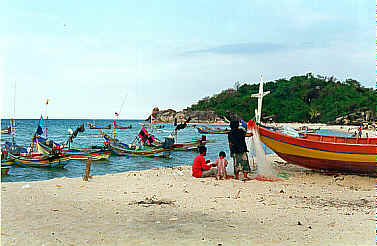
Fishing boats in Songkhla province for coastal fisheries. The livelihood of small-scale fishing families is threatened by the destructive practices of the larger trawlers.
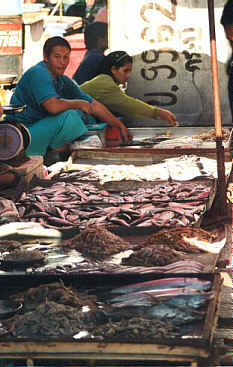
The catch of the day in a local market can reveal some of the problems facing the fisheries industry: large numbers of fish fry and generally undersized fish may be sold in bulk, indicating that undersized nets have been used.
For one thing, watch out for what is on your dinner plate? The restaurant trade in certain species, and the live restaurant trade in general, is responsible for widespread destruction of reefs, and for decimation of the populations of some species. Shark species, in particular, are coming under threat of extinction as a result of the trade in shark fins for shark fin soup. The live reef fish displayed in restaurants throughout Asia are also far costlier in environmental terms than may be immediately apparent when you look at the (still somewhat expensive) price on the menu.Live fish are caught after stunning - usually through the use of sodium cyanide. Smaller fish, invertebrates and coral organisms are also killed by the poison.
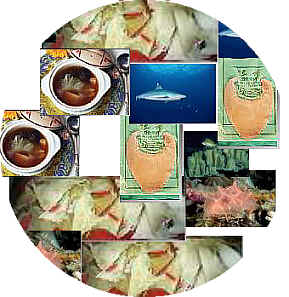
Shark fins and coral - the heavy cost of some seafood dinners
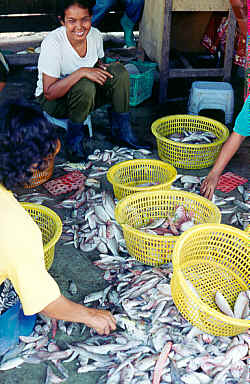
Sorting the catch.
Use of dynamite in fishing - blasting destroys large areas of coral, other organisms, and is dangerous to the people fishing;
Use of poison in fishing (e.g. sodium cyanide) - contaminates the environment, kills coral and other organisms, and can be dangerous to the people fishing and, depending on the poison and concentrations in the fish flesh, to the people consuming the fish;
Small mesh sizes - yields larger catches but these include immature as well as mature, and commercial as well as non-commercial species. In fishing for scrap fish or trash fish, the illegal use of very fine mesh nets scoop up the youngest fish, sometimes of commercially important species.
Fishing in protected areas - in order to protect different kinds of fisheries and to protect spawning grounds or other sensitive areas prohibitions on fishing using particular methods, or prohibitions on all fishing at certain times of year may be imposed. Breaking these rules threatens the effectiveness of these conservation measures;
...cont'd
cont'd.....
The use of electricity - smaller fish are far more susceptible than larger fish, and the users may themselves be in danger from poorly assembled instruments;
Push nets and other nets which scrape the bottom of the ocean - cause extensive damage to bottom-dwelling organisms and disrupt this environment so that it can take years to recover;
Use of intense lights at night - attracts all kinds of fish and other sea creatures towards the lights where they are caught in nets. Not all the species are mature or commercial - a method which leads to over-fishing of affected areas;
Long-line fishing - Sea birds, turtles, and dolphins can all be caught by longline fishing. This practice, where fishermen string bait on hooks on a series of lines up to 60 km in length, attracts other organisms than fish with the bait. Animals such as turtles may be hooked on the lines, or the hooks get trapped in their stomachs, oesophagus etc., eventually leading to their deaths.
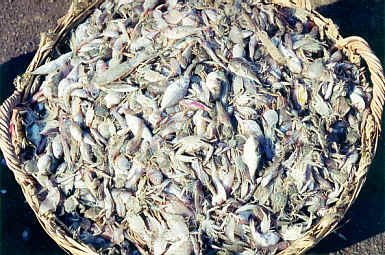
This basket of "trash fish" destined for feed mills rather than the dinner table shows the indiscriminate effects of undersized nets, push and drag-netting, and other forms of destructive fishing practices.
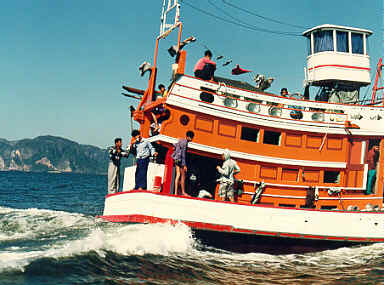
The larger trawlers may spend weeks and even months away at sea seeking "new" more fertile fishing grounds. Back home in Thailand, night-time fishing near the coast by larger trawlers is the current focus of a massive dispute in the fishing industry.
A recent dispute in the fisheries industry along both coasts in Thailand has highlighted the human costs of destructive fishing practices. Small-scale fishing communities find their livelihoods threatened as larger boats use a barrage of lights to draw anchovy into their nets at night. The small-scale fishing communities of both the Gulf and Andaman coasts mounted a barrage of their own at the port at Songkhla and sought assistance from the government in the shape of a ban on night-time fishing with lights. A temporary compromise has resulted in a ban until October 1st when a committee will review evidence of the effects of using lights on coastal fisheries. Unhappy with this compromise, many of the small-scale fisherfolk have protested the inaction of the Democrat-led coalition government by returning their party cards. The South is traditionally the stronghold of the Democrat party - one wonders if the conflict in the fisheries industry will also have long-term political ramifications....
See back issues of The Bangkok Post for more coverage of this issue.
The Global Fisheries Crisis (a Greenpeace summary) with links to Greenpeace campaigns on destructive fishing around the world
Ocean bottom trawling worse than forest clearcutting
Overfishing Targeted in Meetings Worldwide
Deal Reached to Limit Global Fishing Overcapacity
Environment: Eco-labels for World Fish Products
Terrible Tackle (A short briefing on different methods used to catch fish and take souvenirs from reefs)
INTERNATIONAL LAW
GOVERNING
DRIFTNET FISHING ON THE HIGH SEAS
The World Wild Fund for Nature Campaign on Endangered Seas
The World Wild Fund for Nature project in Phang Nga Bay
It's a global problem!
Destructive fishing practices are adversely affecting the sustainability of our fisheries the world over. Here is a small selection of links to articles being written on and actions being taken to prevent destructive fishing practices around the world.
It's not just the fisheries industry that is causing problems in the oceans. The tourism industry is also responsible for significant problems, including taking of coral, shells and other sea creatures for souvenirs, increasing demand for exotic sea food, and generating pollution in coastal areas. The links opposite highlight some of the issues associated with coastal tourism (something NESSThai will be coming back to in other features and research!).